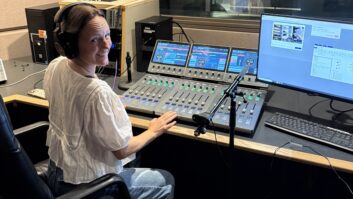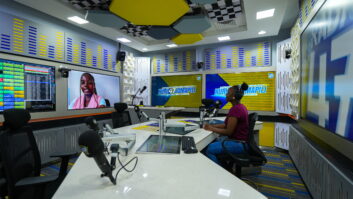Your masked correspondent with smoking solder gun in hand begins his 10th year of observations and Radio World commentary in this, the first issue of RW Engineering Extra for 2008.
Making room for a new calendar as I did in January prompts a look back on how our industry grappled with the past year’s challenges and what’s likely to occur moving into the new year.
Practically all of our predictions for 2007 a year ago became reality, but there were also a few new developments that will help sharpen the focus of how radio will fit into the crowded and ever-changing multimedia landscape.
Let’s do a quick recap, then take a close look at one new product that just might bring significant change.
FULL-TIME HD BECOMES LAW
FCC adoption of HD Radio standards and deployment of full-time AM HD captured lots of attention in early fall of last year. FM HD and HD2 channels grew at a snappy pace, but the AM HD rollout seems to have stagnated and remains mired in controversy. The anticipated wave of filed interference complaints did not materialize, with the WYSL(AM) vs. WBZ(AM) story as the one notable exception. There will likely be similar challenges from other unlucky stations, especially rim-shooters that have been shoe-horned in to serve a larger nearby market or its suburbs.
I do not see this lingering interference controversy changing the AM HD rollout or its potential to effect significant improvement in the AM service any time soon.
What will likely happen is the larger interfering stations will negotiate and buy off the complaints if they are convinced AM HD will help them long-term. The new rules do allow bilateral negotiations to resolve complaints. But look for AM HD to have little impact on how most AM station owners decide to keep their stations viable.
I do not expect Ibiquity, the NAB or the FCC to change course or offer any real help to those stations that have lost important coverage. In the long run, most surviving stations will choose to bypass the AM HD hybrid mode before the benefits of all-digital can be fully realized and appreciated. I hope I’m wrong about those predictions.
ROLLOUT ROLLS INTO UNCERTAINTY
FM HD will continue to grow with more “secret channel” offerings. Because most operational HD station owners are members of the HD Alliance, the supplemental HD2 and HD3 channels will mostly be non-commercial for another year, ostensibly to gain quicker acceptance without ad clutter.
But the rubber will not meet the road on whether the added channels will be of any real value until more HD Radios find their way into the hands of consumers. Until they appear as standard OEM equipment in most new cars and not as added-cost options, mass acceptance of HD may not be a winner and the new channel offerings will not be a factor.
I am betting that before any big car company will be willing to offer HD Radios as standard equipment in all models, major licensing fee concessions will have to be extracted from Ibiquity. That could happen in 2008 as Ibiquity and its broadcast partners become more concerned about the slow acceptance and long-term viability of HD. That should force Ibiquity quietly to renegotiate their fees and royalty structure.
The other “ace card” Ibiquity may consider playing in 2008 to rescue the rollout is requesting the long-rumored 10 dB digital power increase. That will most certainly improve digital reception and reliability, but at the expense of added noise in existing analog receivers.
However, this trade-off will stoke the fires of controversy all over again and likely take several years to unwind before some form of compromise is achieved.
The year 2007 did bring a number of new HD Radio models that perform better than early offerings. RF sensitivity and the need for external antennas for inside reception is still an issue. Boston Acoustics abruptly discontinued the Recepter with no indication that an improved replacement version would be offered.
The overdue battery-powered portable HD models are still being perfected and need to become a marketplace product this year. Ditto for models that store content and replay on demand, i.e. Radio TiVo. Hopefully the Sony, and other new entries into the HD receiver space with Apple’s i-Tagging innovation, will help jump start HD Radio sales.
AND THE WINNERS ARE …
As predicted, the FCC did move forward last year with a proposed rule-making to expand the LPFM service.
Despite the sticking points of opening up third-adjacent channels for LPFMs and requiring existing FMs to protect licensed LPFMs for any future changes, this proposal appears to have “fast track” backing and should be adopted in 2008.
Another long-overdue FCC proposal launched last year that offers some AM improvement will allow AM stations the right to license FM translators. Some see this as a token offset for the coverage damage done by AM HD. For smaller markets and especially daytimers, this will be welcome relief. In some cases, it may even allow the AM license to be retired and the translator converted to a minimum power Class A FM.
A 2007 prediction we nailed spot-on is the proposed revamping of EAS. Adding a new 700 MHz communications band for interconnected emergency agencies as well as adopting the use of CAP, the Common Alerting Protocol, promises to bring us a much-improved system. All the players finally got together and hammered out a very good proposal, but it needs additional industry input and support.
MEL MAKES HIS MOVE
Everyone saw the possible merger of satellite operators looming. Almost on cue, Mel Karmazin launched his effort last spring to merge XM with Sirius to give both a better chance of long-term survival.
As I write, decisions from the Justice Department and the FCC have still not been announced. Despite the original intent and force of existing SDARS rules, plus all the antitrust and government-sanctioned monopoly counter arguments, Mel is likely to win this one. But there will be restrictions to appease the opponents.
Ibiquity is taking its shot, wanting mandatory inclusion of HD in all new satellite radios. Satellite not only faces a huge debt problem but also the challenge of even more competition from burgeoning mobile multimedia and wireless internet streaming technologies.
Satellite radio faces more pressure from wireless Internet than terrestrial radio because of the added burden of having to charge subscriber fees. It also has less leverage making real money with paid advertising since its cume totals are so tiny compared to national radio networks and large group-owned operators.
As wireless and mobile Internet use ramps up, both services will have to focus more heavily on streaming and Web site-delivered products. Both will add more video content attracting the younger demos to ensure a place in the Web-dominated multimedia future. Indeed, Karmazin appears to be planning on transitioning Sirius to video-only content if his merger plans are approved.
The new Arbitron PPM world coupled with the precise metrics of Internet connectivity will give advertisers most all the feedback they’ve wanted about who is listening and when. As my old sparring partner Skip Pizzi says, these new tools will “replace the magnifying glass with an electron microscope” for media consumption measurement.
All services will have to adjust, but I’m predicting radio with its long legacy of staying nimble in the face of change and new threats, will do just fine. Over time, broadcasters will have to readjust ad rates as more listeners are delivered via the Internet while those using traditional AM/FM reception will no doubt slowly decrease.
WIRELESS IP RADIO HERE AND NOW
One important prediction we made last year that is now gaining traction is the emergence of wireless IP radio.
There is no demand for wired IP radios, but the ability to listen to wireless Internet audio streaming via cellphones both in and out of the car is pushing this development. Guy Wire reader Alan Smith and I recently engaged in some give and take in our online Mailbag on how relatively easy it now is to listen to Internet radio via a cellphone or a laptop PC in the car.
Radio engineers and geeks are easily impressed with how well G3 cellphones and wireless Internet-equipped laptops are making this possible in well-served urban areas. Consumers, of course, need this capability to be made available in a much easier and low-effort format.
Microsoft and Ford saw this coming several years ago: the need to fully merge all multimedia services into cars. They teamed up to produce Sync, a cool new product unveiled at the 2007 CES. Sync is now available as an option in most 2008 Ford, Lincoln and Mercury model cars.
I test drove a Sync-equipped Ford Focus over the Christmas holidays and it felt like the future.
SYNC UP WITH THE FUTURE
Sync as an option is really more about integrating iPods, MP3 players and cellphones into the built-in audio and control centers of automobiles using speech recognition and hands-free ergonomics. Bring any version of cellphone or player you have and simply connect via USB port and Bluetooth.
The universal combo AM/FM/CD unit driving a multiple-speaker sound system in cars is now yesteryear’s product. Responding to consumer demands to be able to easily use their music players and cellphones with the car’s integrated sound now seems a no-brainer, just like the innovative placing of drink holders in cars 30 years ago.
Many regard Sync as a paradigm-changing product that does not bode well for radio. The salesman devoted most of my demo time hyping the voice-activated cellphone and one-button responder features … and showing me how the built-in computer copied and served up any of my iPod songs on a simple voice command. All audio plays through the impressive pseudo-surround sound speaker system.
He did point out at the end of the demo that I could stream any Internet audio from my Verizon cellphone through the system. When I asked about trying out the built-in AM/FM radio, he seemed dismissively smug, pointing out there was nothing new there and that all cars had those.
This demo unit did not have HD capability, but the sales manager assured me it will be available soon as an additional cost option. That seemed like a pyrrhic victory for HD at best.
How the Internet gets into cars is still a work in progress. Various cellphone companies are accelerating their efforts to be that primary delivery method. Buying unlimited Internet access for an existing cellphone account for about $60 a month is certainly the easiest way to tap into mobile connectivity in most markets.
Last year, I had predicted that community WiFi and WiMax projects designed to cover large areas with tax-subsidized Internet would become an option, but they don’t seem to be getting anywhere. To date, there is little talk about the FCC creating a national band for WiMax services.
In Philadelphia, where Earthlink was contracted to deploy a city-wide WiFi system, the technical performance of the network had problems and there was discussion of not completing the build-out due to the lack of interest and escalating costs. Some of the new wireless Internet services actually prohibit streaming for now.
I expect to see WiMax begin to roll out in earnest after the February 2009 analog TV shutdown but it will probably take longer before we see this at a level where mobile products for cars are in the pipeline.
VALUABLE FEATURES OR GIMMICKS?
As a $395 option, Sync appears to be a winner. With such a glitzy and futuristic play toy now available to the mass market, few are going to pay any attention to the capabilities of the integrated radio, which is a mere tag-along. But then I got to thinking how average users would respond to Sync and which features they would use often and regard as valuable for their $395 investment.
Moving the cellphone out of a driver’s hand and away from his head into the integrated control of Sync is certainly desirable. Many state laws are now requiring hands-free cellphone use in the car anyway. Transferring a few thousand iPod tunes into Sync for instant replay via a big sound system while driving is also an attractive feature.
As I thought about these new features a bit more, it strikes me that most consumers who heavily use their cellphone in the car already have hands-free adaptors or will be compelled to get them soon. Most who prefer non-stop music of their choice while driving have already been using their CD players or iPods via headphones or Bluetooth for quite a awhile. Plus, we are now seeing reports of “iPod burnout” that should slow down the rush for many to make iPods their primary music playback device in cars.
Those who want local news, traffic reports, talk radio shows, local personalities and the like will continue to use the radio. Free and local radio service has been an American birthright for almost four generations. If they live where local radio is too limited or unreliable and are willing to pay for a satellite subscription, they will use that.
Will the speech recognition feature and one-button steering wheel commands in Sync have staying power as the preferred way to use the cellphone? Or will they strike many users as merely gimmicks? Perhaps others will find they may not work reliably? And will bringing the Internet into the car become a must-have feature for cars of the future? The two most important bidirectional communications resources used while driving a car are already covered by GPS navigation displays and the ubiquitous cellphone.
Providing Internet audio streaming in the car can certainly supplement radio listening but beyond that, using the Internet productively demands focus and attention. Drivers need to reserve every bit of that for the number one job of driving.
There seems little doubt, however, that the Internet will join integrated video screens for watching movies as useful options for backseat passengers in larger cars and SUVs.
TEST-DRIVING THE FUTURE
Sync was recently tested as an Internet radio streaming appliance in a Ford Explorer by TheRadio.com in South Carolina. Reed Bunzel is an old radio hand who formed and renamed that company from American Media Services-Internet to sell and promote Internet radio streaming. From all accounts, the field testing was successful. He is convinced this technology will eventually be the primary delivery platform for radio.
But it’s very early in the game to know how well cellphone wireless Internet will be able to handle many thousands of simultaneous connections that hope to support reliable audio streaming in moving cars throughout populated areas.
It’s likely going to take many years and may require G4 technology before this platform can rival the affordability, reliability and coverage capability of broadcast radio. And we have no clear idea if enough of the mass market will prefer Internet streaming to terrestrial and satellite-delivered radio in cars, and are willing to pay extra for it.
The bottom line for options like Internet, satellite radio, GPS displays, integrated cell phones, surround sound systems and other multimedia devices in cars including Sync is that they all come with an acquisition cost. Many require separate ongoing monthly subscription fees. Their providers need to make such options affordable and easy to use for a large number of consumers who want them. If they don’t pass those tests, they don’t succeed.
We’ll be watching the Sync introduction closely. It just might be the future.







